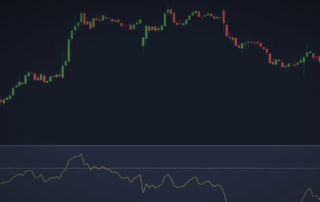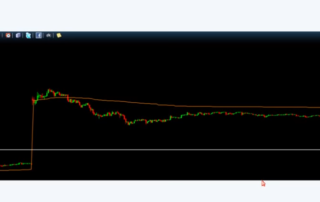The Correct way to use VWAP in your Trading
Knowing what indicators to use and what is the best combination of technical indicators can dramatically improve your chart reading skills. If you use the wrong technical indicators, this can lead to inaccurate price interpretation and bad trading decisions. Technical indicators can make it easy for you to identify current price trends and predict where prices will move in the future and by developing effective technical analysis strategies, you can increase the amount you earn each trading day. When it comes to indicators, we can divide them into four classes: • Trend-following indicators • Momentum indicators • Volume indicators • Volatility indicators Trend indicators – trend indicators are designed to measure the strength and direction of a trend. If a market is in a strong uptrend, a trend indicator gives you a buy signal, and if the market is in a strong downtrend, trend indicators give you a sell signal.
However, since indicators are based on past price-data, most trend indicators lag the price and give trading signals after a trend has already been established. This means a trader will likely miss the initial move of a new trend until a trend indicator sends a trade signal. Popular trend indicators include moving averages, parabolic stop and reverse (Parabolic SAR), average directional movement index (ADX) and the moving average convergence divergence (MACD). Momentum indicators / oscillators – another popular group of technical indicators are momentum indicators, also called oscillators. Unlike trend indicators, oscillators measure the relative strength of recent price-moves and plot a value between 0 and 100 – hence their name. If prices are rising strongly, an oscillator follows and reaches overbought levels, giving you a sell signal. Similarly, if prices are falling, an oscillator reaches oversold levels and sends a buy signal.
Oscillators work extremely well in ranging markets but lead to whipsaws when markets are trending. Popular oscillators include the relative strength index (RSI), stochastic indicator and momentum oscillator. Volume indicators – volume indicators measure the strength of a price-move by using the information of trading volume. While volume indicators are very popular among stock traders, forex traders can’t take much advantage of them since there’re no reliable measures of trading volume in the currency market.
Popular volume indicators are the Chaikin Oscillator and on-balance volume (OBV). Volatility indicators – as their name suggests, volatility indicators measure the rate of price-changes regardless of their direction. Volatility indicators rise when markets are fast and fall when markets are slow. Popular volatility indicators include Bollinger Bands and the average true range (ATR). As you can see, while these categories of indicators are trying to determine the same thing—whether prices are about to increase, decrease, or remain stable—the angle they each offer is unique.
Looking at the market from multiple different angles can help you develop a more accurate, realistic, and actionable perspective. Knowing which one belongs to which category, and how to combine the best indicators in a meaningful way can help you make much better trading decisions. What you need to realize is that, while all technical indicators are useful, they each have their own set of weaknesses. And, combining indicators in a wrong way can lead to a lot of confusion, wrong price interpretation and to bad trading decisions.
The biggest problem with traders is the fact they use different indicators which belong to the same indicator class and then show the same information their charts. If you take a look at this chart, we added 3 momentum indicators (MCD, RSI and Stochastic). Essentially, all 3 indicators provide the same information because they examine momentum in price behavior. You can see that all indicators rise and fall at the same time, turn together and also are flat during no-momentum periods. So, if you trade with a multi-indicator strategy that uses the RSI indicator, MACD indicator and the stochastic indicator you are basically using 3 types of technical indicators that belong in the same category.
These are all momentum indicators that are going to display the same kind of information in one way or the other. Another common mistake is using only trend indicators. This example shows a chart with 3 trend indicators (Parabolic SAR, moving averages and Keltner channels). Again, the purpose of these indicators is the same: identifying trend direction. You can see that during a trend, all indicators are practically indicating the same thing. At the same time, during ranges, they all offer bad signals. I hope you see the problem with adding multiple indicators showing the same information, you will end up giving too much weight to the information provided by the indicators and you can easily miss other crucial things. You might use 2 or more trend indicators and you might believe that the trend is stronger than it actually is because both of the indicators will give you the green light and you might miss other important clues on your charts.
The problem with using unfitting technical indicators is that you might actually think the trade signals are stronger if all indicators point in the same direction. And this is completely wrong! The fix to the over-emphasizing information from using indicators that belong to the same group is quite simple. Avoid using technical indicators that display the same kind of information. The best strategy with multiple indicators combine indicators that show a different type of information. And here’s another common mistake: using way too many indicators. Tell me if this sounds familiar: you find a strategy or an indicator on a forum or here on Youtube. You decide to back test it on a demo. You take a look at your charts and spot a few good entries. The only problem is that it’s missing something… yes, a few more indicators, filters to keep you out of bad trades.
What can you do? There’s only one answer: add more indicators. But which one? No problem, you open your trusty folder of indicators and start trying out different ones. You back test again: now the strategy gives better results… but still you have some losses and since you are on a quest for the Holy Grail, you add another “filter”…. And another… and another, until you realize your charts start to resemble a Christmas tree. And now you’re more confused than ever. Some indicators say “short” while others say “long” and by the time they all agree, price moved 50 pips and it’s too late to enter. What’s worse, you realize you started with a potentially good strategy and modified it almost completely.
I suffered from the same problem, don’t worry. We all did. You don’t need to clutter your charts. Less is more. You might still have a strong belief that each indicator on your chart serves an essential purpose and you cannot trade without all of them. You don’t need to transform yourself into a price action trader, but if your results are not great, get rid of some indicators, you’ll see that your mind will be more active and you’ll start to analyze price movement from a different perspective. • So, limit your use of indicators to 2 or 3 max (preferably 2). • Do not try to filter out all losing trades with the use of indicators. You’ll end up filtering out the good trades as well. • Don’t just add a new indicator after a loss because losses will occur even if you use 100 indicators. • Let indicators confirm your trade bias and don’t follow them blindly Now, here are several combinations of indicators that you could use: 1. One trend indicator and one momentum indicator You could use a moving average to determine the trend, and the stochastic for example for confirmation or as an entry point.
If you watched my stochastic video, you already know that I like to use the 200 EMA to identify the trend, and I use stochastic to find divergences in the direction of the primary trend. When the price is above the 200 EMA, I plan to take long trades, when the stochastic show a divergence, and when the price is below the 200 EMA, I take short trades based on the same divergences offered by the stochastic. 2. You could use a volume indicator and a trend indicator I prefer to use the OBV in combination with the moving average. My personal preference is to add a long-term moving average on the on-balance-volume. This helps me to determine the direction of the trend – as this crossover offers an excellent outlook on the prevailing trend on the market. When the OBV is above the moving average, i search for long positions, in the direction of the main trend.
When OBV is below the moving average, I take only short positions. 3. A volatility indicator and a momentum indicator is also a good fit. I like to use the Bollinger bands and the RSI indicator, to search for divergences when the Bollinger bands are flat. You can use any other indicators. What type of indicator you decide to use to develop a strategy depends on what type of strategy you intend to develop. This relates to your trading style and risk tolerance. If you seeks long-term moves with large profits, then you might focus on a trend-following strategy, and, therefore, utilize a trend-following indicator such as a moving average. If you’re interested in small moves with frequent small gains, you might be more interested in a strategy based on volatility. Again, different types of indicators may be used for confirmation. Traders often talk about the Holy Grail – the one trading secret that will lead to instant profits. Unfortunately, there is no perfect strategy that will guarantee success for each investor. Each trader has a unique style, temperament, risk tolerance and personality. As such, it is up to each trader to learn about the variety of technical analysis tools that are available, research how they perform according to their individual needs and develop strategies based on the results.
If you got any value from this and learned something new, don’t forget to subscribe, hit the bell icon to enable notification and leave us a like to show your support. Until next time..
Keywords: How to combine trading indicators, trading indicators, trading indicators explained, technical indicators, trading indicators forex, trading indicators for beginners, how to use trading indicators, best trading indicators, technical indicators for day trading, technical indicators for swing trading, forex indicators for beginners, stock indicators, best indicators for stock trading, Forex and cfd, cfd day trading, the secret mindset
Bitcoin Halving, Explained
An event that halves the rate at which new [...]
BITCOIN EXPLODES INTO THE NEW YEAR!!! 🚀 Will ALTCOINS FOLLOW in 2020? $9k BTC?
what's going on guys it Kade up here [...]
Best Scalping Trading Strategy | How To Scalp Forex & Stock Market Effortlessly
hey guys in this video I will show [...]
RSI Day Trading | Best Strategies To Trade With RSI Indicator
Every time i read an article or see [...]
The Correct way to use VWAP in your Trading
okay so this lesson is gonna be about V [...]
Morbi vitae dui euismod vulputate sollicitudin
Donec finibus sit amet orci eget ultricies. Praesent posuere ante [...]






